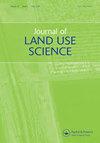臭氧-电处理对污泥中重金属Cu富集转移的影响
IF 3.3
4区 环境科学与生态学
Q1 AGRICULTURE, MULTIDISCIPLINARY
引用次数: 0
摘要
为了探索一种安全、有效地利用污泥作为农业肥料的方法,必须对污泥中所含的重金属进行有效的分离和去除。本研究采用臭氧-电两级处理对污泥中的重金属铜进行转化,处理后的污泥用于玉米生产,并在培养基和植株中进行Cu的转移,研究了Cu在植株中的富集效果。玉米种植试验按培养基成分设置5个处理:CK、农用土不添加;T1、农用土加原污泥;T2、臭氧污泥处理农业土壤;T3、臭氧处理和电处理污泥的农业土壤;T4、农用土壤加普通有机肥。结果表明:在不同处理下,各器官铜含量表现为根>茎>叶>穗轴>粒。根系Cu含量以T1处理最低,为11.60 mg/kg,籽粒Cu含量以CK处理最低,为1.36 mg/kg。在上、中、下层土壤中,T4和CK的Cu含量最高、最低。在中下层土壤中,T1、T2和T3污泥处理的Cu含量均呈现T1>T2>T3的趋势;在同一土层中,不同器官对铜的富集能力差异不显著。从各处理来看,CK植株富集Cu的能力均高于其他处理。根据Cu向植株地上部转移的能力,处理顺序为CK>T3>T4>T1>T2。土壤中铜向植物的转移主要受肥料水平的影响,土壤中铜向茎、叶和根的转移速率较高,但受污泥影响不大。综上所述,臭氧电处理后,污泥的施用对玉米中Cu含量的影响不显著,各处理的Cu含量均未超过农业生产限定值。本文章由计算机程序翻译,如有差异,请以英文原文为准。
The Effect of Ozone-Electric Treatment on the Enrichment and Transfer of Heavy Metal Cu in Sludge
In order to explore a safe, effective way to use sludge as agricultural fertilizer it is necessary to effectively separate and remove the heavy metals embedded in sludge. In the study, the ozone-electric two-stage treatment was used to transform heavy metal copper in the sludge, and then the treated sludge was used for maize production and the transferring of Cu in cultivation medium and plants, and the enrichment effect of Cu in plant were investigated. According to composition of culture substance, five treatments were set in maize planting experiments: CK, Agricultural soil without addition; T1, Agricultural soil supplemented with raw sludge; T2, Agricultural soil treated with ozone sludge; T3, Agricultural soil with ozone treated and electric treated sludge; T4, Agricultural soil added with common organic fertilizer. The results showed that in different treatments, the Cu content of organs showed the order of root> stem> leaf> cob> grain. Comparing root Cu content, the lowest was in T1 treatment, which was 11.60 mg/kg, while the lowest of grain Cu content was found in CK treatment, which was 1.36 mg/kg. In the upper, middle and lower soil layers, the highest and lowest Cu content was in T4 and CK, respectively. In both middle and lower soil layers, the Cu content of T1, T2 and T3 sludge treatments had a trend of T1>T2>T3; the difference of the Cu enrichment ability between different organs is not significant in the same soil layer. From each treatment, the Cu enrichment ability of plant of CK was higher than that of other treatments. According to the ability of Cu transferring to the above-ground part of plant, treatments are ranked as CK>T3>T4>T1>T2. The transferring of Cu from soil to plant was mainly affected by fertilizer level and the transferring rate of Cu from soil to stem, leaf and root was relatively high, but it was hardly affected by sludge. In summary, after ozone-electro treatment, the application of sludge does not significantly affect the Cu content in maize, and the Cu content in each treatment does not exceed the limit value of agricultural production.
求助全文
通过发布文献求助,成功后即可免费获取论文全文。
去求助
来源期刊

Journal of Land Use Science
Environmental Science-Management, Monitoring, Policy and Law
CiteScore
5.40
自引率
6.20%
发文量
26
期刊介绍:
The Journal of Land Use Science provides a central outlet for high-quality articles on theoretical and empirical aspects of land-use science at the interface of social and environmental systems. The Journal brings together an array of research perspectives at multiple temporal, spatial and social scales that contribute a better understanding of land-system dynamics and communicate scientific advances towards attaining land-system sustainability.
 求助内容:
求助内容: 应助结果提醒方式:
应助结果提醒方式:


